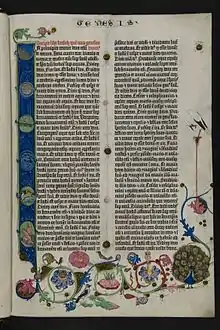vetero-testamentary
See also: veterotestamentary
English
WOTD – 18 April 2023
Etymology
| PIE word |
|---|
| *tréyes |

The beginning of the Book of Genesis in the Old Testament in a copy of the Gutenberg Bible (circa 1450s) in the collection of the Berlin State Library, Berlin, Germany.
From Latin vetus, veteris (“ancient, old”) + English testamentary (“pertaining to a testament or will”).
Pronunciation
- (Received Pronunciation) IPA(key): /ˌvɛtəɹəʊˌtɛstəˈmɛntəɹi/, /ˌvɛtɹəʊˌtɛstəˈmɛntɹi/
Audio (Southern England) (file) - (General American) IPA(key): /ˌvɛtəɹoʊˌtɛstəˈmɛntəɹi/, [ˌvɛɾəɹoʊˌtɛstəˈmɛnɾəɹi]
- Rhymes: -ɛntəɹi
- Hyphenation: ve‧te‧ro-te‧sta‧ment‧a‧ry
Adjective
vetero-testamentary (not comparable)
- Of or pertaining to the Old Testament of the Bible. [from mid 20th c.]
- Synonyms: Old Testamental, (rare) paleotestamentary
- Coordinate term: neo-testamentary
- 1961, André Grabar, “The First Steps”, in Christian Iconography: A Study of Its Origins (The A. W. Mellon Lectures in the Fine Arts; Bollingen Series; XXXV.10), Princeton, N.J.: Princeton University Press, →OCLC, page 11:
- But whether the Christians knew, at the beginning, image-signs of Jewish making or only Jewish prayers with the formula: Save me as you have saved Noah, etc., the great proportion of veterotestamentary salvations in the catacombs and on the sarcophagi, but especially in the catacombs, makes it very probable that there was some initial Jewish contribution.
- 1963 August, Peter Riga, “Origins and Meaning of the Christian Altar”, in The American Ecclesiastical Review, volume CXLIX, number 2, Washington, D.C.: The Catholic University of America Press, →ISSN, →OCLC, page 102:
- By this brief analysis of vetero-testamentary evolution of the notion of the altar we simply wish to show the solicitude for and importance of the altar for the Jews of old.
- 1983, Pierre-Marie Gy, “BENEDICTIONS”, in Joseph R[eese] Strayer, editor, Dictionary of the Middle Ages, volumes 2 (Augustinus Triumphus–Byzantine Literature), New York, N.Y.: Charles Scribner’s Sons, →ISBN, page 178, column 1:
- Episcopal benedictions generally occur before Communion during mass (after Communion, according to Gulielmus Durandus of Mende). These are inspired by the vetero-testamentary benediction of the Book of Numbers (6:22–26) and include three invocations, often rhythmic and rich with assonance, to which the people respond with "Amen."
- 1991, Jean-Luc Marion, “The Idol and the Icon”, in Thomas A. Carlson, transl., God without Being […] (Religion and Postmodernism), Chicago, Ill., London: University of Chicago Press, published 1995, →ISBN, pages 7–8:
- Indeed, a determination that would limit itself to opposing the "true God" (icon) to the "false gods," in extending the polemic of the vetero-testamentary prophets, would not be suitable here.
- 1995, François Bovon, “The Importance of Meditations in Luke’s Theological Plan”, in Jane Haapiseva-Hunter, transl., New Testament Traditions and Apocryphal Narratives, Eugene, Or.: Pickwick Publications, Wipf and Stock, published 22 October 2008, →ISBN, page 57:
- One can go even further and remark that it is in the infancy stories, just where the humanity of the Messiah appears, that Luke picks up the veterotestamentary themes of the actual presence and the voice of God and applies them to Jesus.
- 1999, Jean-Marie van Cangh, “Evolution in the Tradition of the Last Supper (Mk 14,22–26 and par.)”, in Bernd Kollmann, Wolfgang Reinbold, Annette Steudel, editors, Antikes Judentium und Frühes Christentum: Festschrift für Hartmut Stegemann zum 65. Geburtstag [Ancient Judaism and Early Christianity: Festschrift for Hartmut Stegemann for His 65th Birthday] (Beihefte zur Zeitschrift für die neutestamentliche Wissenschaft und die Kunde der älteren Kirche [Supplements to the Journal for New Testament Studies and the Ancient Church]; 97), Berlin, New York, N.Y.: Walter De Gruyter, →ISBN, →ISSN, page 376:
- Commentators have long remarked the legendary style of the account of preparation of the festive room by two disciples who meet a man carrying an urn of water who leads them to an unknown but providential landlord (Mk 14,12–16). This account is modelled on the vetero-testamentary episode of the recovery of the asses of Saul by Samuel (I Sam 10,3–6).
- 2013, Alexandra F. Vukovich, “Motherhood as Authority in the Life of Queen Helen by Archbishop Daniel II”, in Sini Kangas, Mia Korpiola, Tuija Ainonen, editors, Authorities in the Middle Ages: Influence, Legitimacy, and Power in Medieval Society, Berlin, Boston, Mass.: Walter De Gruyter, →ISBN, →ISSN, page 263:
- The veterotestamentary analogies embody a constitutional and moral value whereby the Nemanjid dynasty is granted historical and charismatic legitimacy.
- 2018, Estella Ciobanu, “Commemorations of Christ’s Passion Body: Ostentatio Vulnerum, Redemptive Theology and Violence of Representation in the Post-Crucifixion Plays”, in Representations of the Body in Middle English Biblical Drama (The New Middle Ages), Cham, Switzerland: Palgrave Macmillan, Springer Nature, , →ISBN, footnote 31, page 229:
- One of the revisionist Protestant strategies aimed to justify repudiation of Catholicism was the gendering of religious behaviour […]. At its simplest, yet most insidiously dangerous, it associated vetero-testamentary or pre-conversion characters with the old/Catholic religion and gendered them feminine or effeminate—unruly speech- and behaviour-wise, viz. overly emotional, even exhibitionist and ultimately anti-Christian. By contrast, positive neo-testamentary characters, Christian converts and generally reformed figures were deemed the true Christians/Protestants.
Alternative forms
Related terms
Translations
of or pertaining to the Old Testament of the Bible
|
Further reading
 Old Testament on Wikipedia.Wikipedia
Old Testament on Wikipedia.Wikipedia
This article is issued from Wiktionary. The text is licensed under Creative Commons - Attribution - Sharealike. Additional terms may apply for the media files.